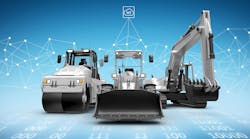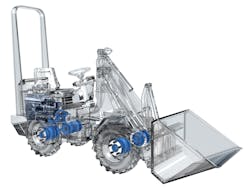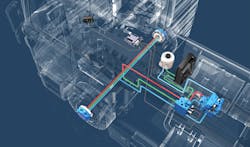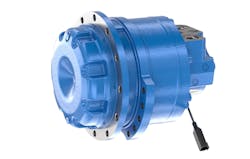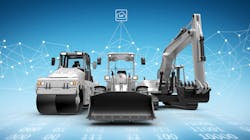The hydraulic radial piston motor is a key component used to power and drive a broad range of mobile machines. Functioning as a direct drive, it operates as a low-speed, high-torque hydraulic motor coupled directly to the axis it is moving, so there is no requirement to add a gearbox in between. Because they can deliver high power densities in a very compact package, radial piston motors are well suited for wheeled, tracked and chain-driven equipment.
They are also rugged, with a minimal number of moving parts that do not require routine maintenance. These motors are engineered for operating environments in mines, construction sites, forestry and agricultural settings that demand heavy-duty performance and the ability to move big machines and large loads in rough terrain.
As a result, these fundamental features—power density, compact size, rugged design and high performance—have made the radial piston motor a reliable mobile machine drive for decades. And while these types of motors are considered a mature technology, innovative new features and drive concepts continue to appear to tackle the new demands and requirements from mobile machine OEMs and end-users across multiple industries.
Benefits of Low-Speed, High-Torque Direct Drives
Radial piston motors often power machine functions that require significant force to move heavy loads, such as the chain drives for augers and conveyor belts in asphalt laying equipment. They also provide fine positioning control more precisely than solutions that incorporate high-speed motors and gearboxes. For example, by using a radial piston motor to control the slew drive that rotates the upper body of an excavator 360 deg., it becomes easier for the machine operator to control the stop-point, positioning the bucket to do work.
Across multiple industry segments, mobile machine end-users value drive systems that deliver optimal fuel efficiency, high power density, maximum productivity and reliability. Added to these performance requirements are systems with compact footprints so they can fit into tight mobile machine frame spaces.
Responding to industry requirements for radial piston equipment, Bosch Rexroth developed a wide range of versatile, modular motor designs incorporating features for specific application needs. As a result, this hydraulic motor technology offers mobile machine OEMs and end-users several benefits:
- High volumetric and mechanical efficiency. To ensure maximum fuel economy, all radial piston motors have optimized sealing and low-friction properties within flow passages and rotating elements.
- Increased starting efficiency and smooth rotation. Precise control, even with shaft speeds as low as 0.5 rpm, is achieved through a rotary group design optimized for high-temperature applications and maximum efficiency without compromising durability.
- High temperature range capability. Tribological developments in the rotary group design have improved durability and resistance to high temperatures, which aids in reducing the overall system cooling requirement.
- Low operational sound levels. Low-speed, high-torque direct drives have very smooth interacting mechanical parts. This results in lower operational noise levels compared with other technologies such as gearboxes. Combined with hydraulic fluid flow optimization design enhancements, radial piston motors are a valuable way for mobile machine manufacturers to meet increasing customer demands for lower noise emissions from hydraulic components.
In addition, modular design offers integrated drive solutions for a wide range of customer applications. One example is the use of a radial piston half motor in combination with a drive axle. The versatility of this design also allows for the option to connect a second shaft for dual axle drive (four-wheel drive). The direct drive characteristics of the low-speed, high-torque radial piston motor eliminates the requirement for a drop box. In doing so, the vehicle ground clearance is greatly improved, and total machine costs are reduced.
Advances for Evolving Industry Needs
Despite their long service, new radial piston motor technology concepts and design advances continue to emerge to address ongoing OEM and end-user requirements. Reliability and maximum machine uptime are critical industry drivers.
There is also an expanding movement to apply IoT technology to enable OEMs and end-users to monitor and capture a wider range of real-time operational data about radial piston motor performance. End-users are always concerned about preventing unscheduled downtime, which can be quite costly since most machines using radial piston motors are expensive to operate in high-value applications.
In order to provide real-time data that machine operators can use to plan predictive maintenance programs, or to intervene to prevent major equipment failures, a broader range of sensors are being introduced. These include pressure sensors, temperature sensors and vibration sensors.
These sensor arrays are linked through mobile equipment controllers and new edge computing devices, with cloud connectivity now being introduced into many construction and off-highway mobile electronics portfolios. In addition, this data can also be relevant to operators to improve how they use and manage equipment in the field.
This includes new business models where equipment is leased to construction firms or other operators with cost parameters based on uptime commitments. Having real-time radial piston motor data can help ensure equipment is properly maintained. In addition, mobile machine OEMs are increasingly looking for more real-time, real-world sensor and operational data to help guide research and development efforts to design the next generation of products.
New Designs Enhance Efficiency & Performance
There are also ongoing efforts to improve energy efficiency and reduce emissions in mobile machines by improving radial piston motor designs. By continually enhancing motor efficiency, it is possible to help reduce fuel consumption and diesel emissions from the mobile machine without impacting its ability to deliver a full day’s work. This includes efforts to downsize the overall size of radial piston motors without giving up performance, depending on their application, so they can fit into tighter machine envelopes.
For example, Bosch Rexroth introduced its MCR-T compact drive solution for track and wheel applications. The design provides a 10% improvement in starting efficiency compared to conventional designs while featuring an optimized shaft position that accommodates higher radial loads due to better load distribution.
For tracked-drive applications, a parking brake is required on the drive motor. To save space, the parking brake was moved inside the motor rather than being located externally, reducing the motor’s overall length by 20%. By reducing the size, it can be incorporated into a larger variety of mobile machines using track drives while saving component weight as well, which can help with fuel efficiency or equipment output. There are opportunities to incorporate this space-saving design into other radial piston motors, such as those used on skid steer loader drives.
Radial piston motor designers are also enhancing ways to provide greater speed for wheel drives so that mobile machines can move faster from one work location to another. This involves using a reduced displacement mode that reduces the number of active pistons that are transferring hydraulic power into rotational torque, thus increasing speed. Operators can select which displacement mode to use depending on the machine performance demands. This makes it possible to increase the radial piston motor’s speed without having to install a larger displacement hydraulic pump.
Another significant advancement in the application of radial piston motor technology is the Hydraulic Traction Assistant (HTA) platform. This system is designed to provide added traction power on demand to the steering axle on heavy-loaded, 18-wheel trucks, such as those that haul loads in difficult ground conditions where traction is poor.
The system combines two radial piston motors integrated into each side of the front axle, along with hydraulic axial piston pumps, a control block and sensors, and an electronic hydraulic controller with an operator interface. In neutral mode, used when added traction is not needed, the radial piston motor is inactive, reducing drag losses to a minimum and improving fuel efficiency compared to a mechanical, all-wheel drive system.
When the operator has a full load and needs traction to drive out of the pit, the system is automatically or manually engaged. This transfers power and torque from the truck’s diesel engine to the radial piston motors via the closed-loop hydraulic pumps, adding traction power to the steering axle. Once the vehicle has reached sufficient speed—approximately 18 mph—the system automatically returns to neutral mode unless the operator chooses to keep it engaged.Expanding the Value of Radial Piston Motors
Boosting vehicle traction is just one example where the compact dimensions and power density of radial piston motors can provide a powerful way to apply the technology in new and effective ways. Mobile machine builders are working with key radial piston motor and system providers to apply this technology, taking advantage of new developments to improve the versatility and performance of their equipment offerings.
Understanding the evolving needs of mobile machine end-users is also critical to sustaining innovation in radial piston motor technology. Key system and component suppliers that have vast experience in hydraulics technology—along with a long history of engineering and developing radial piston motor products and systems for specific machine requirements—are helping to ensure radial piston motor technology continues to improve to keep up with today’s evolution in mobile machinery demands.
Steve Zelich is product manager – radial piston motors at Bosch Rexroth Corp.
